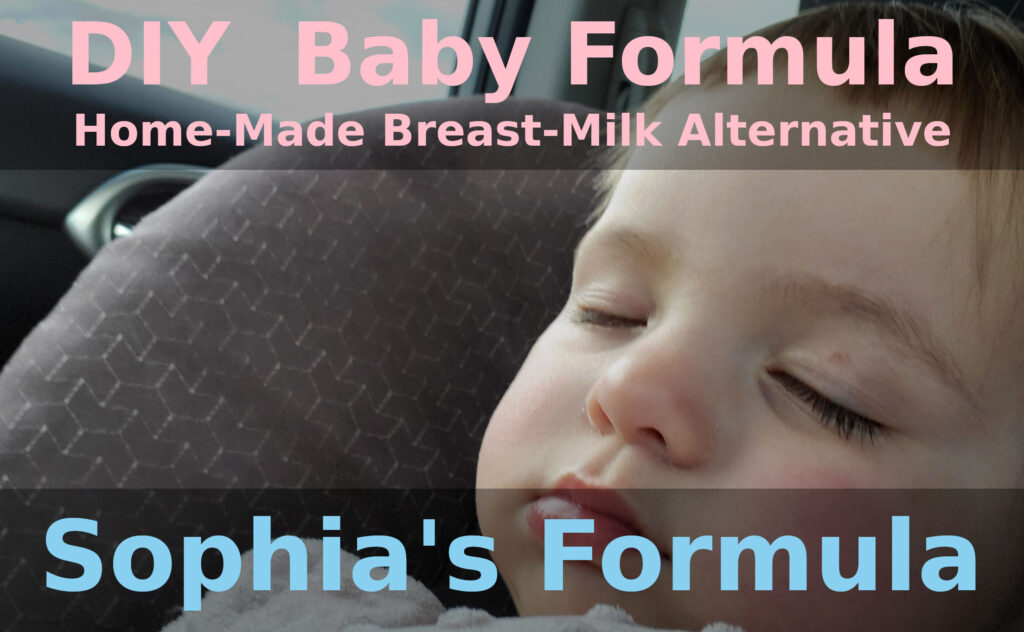
Disclaimers:
The following is not medical advice and it is not nutritional advice. Talk to your pediatrician before implementing dietary changes. This DIY baby formula has not been evaluated by the FDA.
Jump to Recipe
Sophia’s Home-Made Baby Formula

When my baby was born, I was one of those unfortunate moms who just didn’t make enough milk. But, since I understand the benefits of breast milk (but didn’t have enough) and was painfully aware of the drawbacks of commercial formula, I knew that I had to do better for my infant. My husband Richard being who he is, decided to reverse-engineer a home made formula starting with the macro-nutrient composition of breast-milk and working backwards using natural ingredients. In the process, he cut out all of the fillers that we didn’t want to feed to baby Sophia Grace.
We now have a happy, vigorously healthy (and allergy free) toddler named Sophia Grace. Here and there in my practice, I’ve shared Sophia’s Formula with a handful of patients in my practice that needed a formula that better respected the principals of natural medicine and whole food ingredients.
Feel free to customize/improve this recipe to better fit availability of ingredients. Just avoid cheap oils like Canola Oil etc. Use organic/natural versions of the ingredients whenever possible.

Breast-milk is higher in sugars/carbs than you might think. Focusing on fitness, most of us want to limit our sugar intake in favor of muscle-supporting proteins and healthy fats that increase satiation. In contrast, newborn babies are trying to gain A LOT of weight fast. Being in the womb limits the maximum size that a baby can be due to the physical constraints of female anatomy. This means that when the baby is born, it’s way behind on its growth compared to creatures that develop embryos outside of the mother. Science aside, babies have to put on a lot of weight fast! So, it’s carbs to the rescue. I could go on about how/why we chose the ingredients/ratios we did, but we know you’re here for the recipe so let’s get on with it.
Sophia’s Formula Recipe
Method:
All ingredients added to empty 32 oz mason jar with hot water added to make mixture total 32 fl oz.
| Ingredient | Amount | Calories | Fat | Carbs | Cholesterol | Protein |
|---|---|---|---|---|---|---|
| Goat Ghee | (2 tsp) | 90kcal | 10.0g fat | 0g carbs | 10mg cholesterol | 0g protein |
| Goat Milk powder | (*5 tblsp) | 175kcal | 8.75g fat | 13.8gcarbs | 31.25mg cholesterol | 10g protein |
| Grapeseed oil | (0.5 tsp) | 22kcal | 2.3g fat | 0g carbs | 0mg cholesterol | 0g protein |
| Molasses | (*1.5 tsp) | 30kcal | 0g fat | 7.5g carbs | 0mg cholesterol | 0g protein |
| Sunflower Oil | (*2.5 tsp) | 108kcal | 11.67 fat | 0g carbs | 0mg cholesterol | 0g protein |
| Lactose Powder | (*4 tblsp & 1 tsp) | 195 kcal | 0g fat | 52g carbs | 0mg cholesterol | 0g protein |
| acerola powder | (1/4th tsp) | 0 kcal | 0g fat | 0g carbs | 0mg cholesterol | 0g protein |
| Infant multivitamin powder Klaire labs w/ trace element |
(1/4th tsp) | 0 kcal | 0g fat | 0g carbs | 0mg cholesterol | 0g protein |
| probiotic powder (1/4th tsp) | 0 kcal | 0g fat | 0g carbs | 0mg cholesterol | 0g protein | |
| Zarbee’s Natural Baby w/ iron | (2 ml) | 0 kcal | 0g fat | 0g carbs | 0mg cholesterol | 0g protein |
| Total | 620kcal | 32.72g fat | 73.3gcarbs | 41.25mgcholesterol | 0gprotein |
| Macro | Amount | Unit of Measure | Scale |
|---|---|---|---|
| Calories | 65.54 | K-Cal | per 100ml |
| Fat | 3.46 | grams | per 100ml |
| Protein | 1.06 | grams | per 100ml |
| Lactose | 7.74 | grams | per 100ml |
| Iron | 63.42 | mcg | per 100ml |
| Macro | Amount | Unit of Measure | Scale |
|---|---|---|---|
| Calories | 65.0-70.0 | K-Cal | per 100ml |
| Fat | 3.2-3.6 | grams | per 100ml |
| Protein | 0.9-1.2 | grams | per 100ml |
| Lactose | 6.7-7.8 | grams | per 100ml |
The mean macronutrient composition of mature, term milk is estimated to be approximately 0.9 to 1.2
g/dL for protein, 3.2 to 3.6 g/dL for fat, and 6.7 to 7.8 g/dL for lactose. Energy estimates range from 65
to 70 kcal/dL
source: https://www.ncbi.nlm.nih.gov/pmc/articles/PMC3586783/
Breast milk is 1% protein, 6.9% carbohydrate and 4.4% fat by weight, or 5.6% protein, 38.8%
carbohydrate and 55.6% fat by calories. It is low in protein and high in both fat and carbohydrates… Or
is it? …basically, paleo blogger says breast milk skews to sugar/carbs because babies have very high
energy requirements.
Source: https://mostlymeatiswhatieat.blogspot.com/2013/06/what-can-we-learn-for-breast-milk-part.html
Questions About Seed Oils
While there are certainly valid reasons to be critical of seed oils, complex systems are not one dimensional. French fries scorched in canola oil are not a direct comparison to sunflower and grape seed oils as an ingredient that is kept well below the flash point. I chose Sunflower and Grape Seed oils to avoid infant food allergies, among many other reasons. Many kids have nut or avocado allergies. Also, infants’ gut lining has not fully solidified, so we are cautious about nuts and certain oils in the first year of life. Kids with avocado allergies may also be allergic to latex, kiwi and other latex mimicking foods. It’s also important to understand that most adult nutrition plans in the United States are geared toward weight loss and limiting calories. In contrast, infants need to put on weight very quickly. In the 1st five months of life outside the womb, a healthy baby is supposed to double its body weight; so you can’t compare infant nutrition advice to adults.
See: https://pubmed.ncbi.nlm.nih.gov/16583955/
Yes, there are certain negative aspects around grape seed oil, especially if you cook with it. However, on the positive side, grape seed oil contains the following: linoleic acid (essential fatty acid), flavonoids, vitamin E, and oligomeric proanthocyanins. These are all used to form the backbone of healthy fatty acids such as phosphoplipids, which are used to create cell membranes in the body. These compounds are important for brain cell and tissue development. Everything from proper eye sight to healthy brain and nerve tissue requires fatty acids.
See: https://pubmed.ncbi.nlm.nih.gov/27559299/
Sunflower oil, although not my favorite, is less allergenic than avocado oil and it also contains lecithin, which helps in neurological development, improves and balances cholesterol and fat utilization. Sunflower oil and sunflower seeds are also a good source of selenium, which is vital for proper thyroid function and heart health. Thyroid function in growing babies is vital to hit normal growth markers and brain development.
See: https://pubmed.ncbi.nlm.nih.gov/2000274/
Interestingly, women are chronically deficient in both lecithin, selenium as well as other trace minerals. In developing this formula, it was important to compensate for common nutrient deficiencies found in modern societies.
See: https://pubmed.ncbi.nlm.nih.gov/33265961/
I hope this helps clarify our reasoning for choosing these oils.
Yours in Health,
Dr. Danielle Lockwood
Also note that most of the setbacks with these oils are related to using rancid oil or heating these oils past a smoke point, which neither scenario is the case with this baby formula.

Please please reconsider this recipe! The oils need to be replaced with something like avocado, olive, macadamia.. those vegetable oils you recommend are dreadful!
Look at the work of Dr Cate Shanahan
https://drcate.com/list-of-good-fats-and-oils-versus-bad/
While there are certainly valid reasons to be critical of seed oils, complex systems are not one dimensional. French fries scorched in canola oil are not a direct comparison to including sunflower and grape seed oils as an ingredient. I chose Sunflower and Grape Seed oils based on trying to avoid food allergies, among other reasons. Many kids have nut or avocado allergies. Also, infants’ gut lining has not fully solidified, so we are cautious about nuts and certain oils in the first year of life. Kids with avocado allergies may also be allergic to latex, kiwi and other latex mimicking foods. It’s also important to understand that most adult nutrition plans in the United States are geared toward weight loss and limiting calories. In contrast, infants need to put on weight very quickly. In the 1st five months of life outside the womb, a healthy baby is supposed to double its body weight; so you can’t compare infant nutrition advice to adults.
The longer answer is appended to the article above.